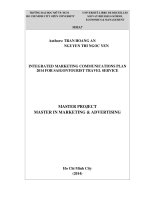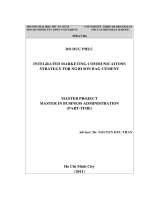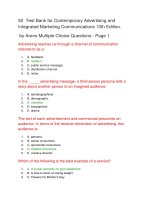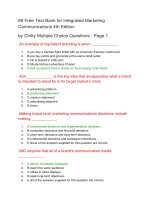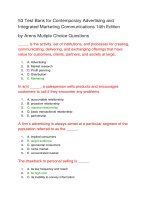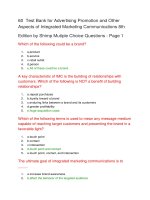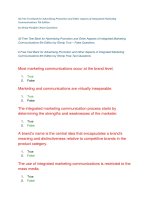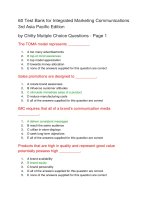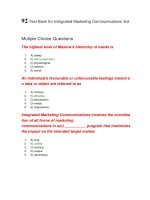Integrated marketing communications plan 2014 for SaiGonTourist travel service
Bạn đang xem bản rút gọn của tài liệu. Xem và tải ngay bản đầy đủ của tài liệu tại đây (1.67 MB, 46 trang )
TRệễỉNG ẹAẽI HOẽC Mễ TP. HCM UNIVERSITE LIBRE DE BRUXELLES
HO CHI MINH CITY OPEN UNIVERSITY SOLVAY BRUSSELS SCHOOL
ECONOMICS & MANAGEMENT
MMA7
Authors: TRAN HOANG AN
NGUYEN THI NGOC YEN
INTEGRATED MARKETING COMMUNICATIONS PLAN
2014 FOR SAIGONTOURIST TRAVEL SERVICE
MASTER PROJECT
MASTER IN MARKETING & ADVERTISING
Ho Chi Minh City
(2014)
PROJECT APPROVAL
This is to certify that I have read and approved the final project of Ms. Tran Hoang An and
Ms. Nguyen Thi Ngoc Yen entitled “Integrated Marketing Communications Plan 2014 for
Saigontourist Travel Service”. I recommend the project for acceptance in fulfillment of the
requirements for the Master in Marketing and Advertising degree.
Tran Vinh
Project Tutor
1
COMMITMENTS
We commit that this final project on “Saigontourist Travel Service’s Marketing
Communications Plan 2014” has been done by ourselves in fulfillment of the Master
degree in Marketing and Advertising only. All analysis and recommendations are based on
the information and data collected from the public and Saigontourist Travel Service. No
recycling for commercial uses should be allowed here.
2
ACKNOWLEDGEMENT
We wish to express our great gratitude to our tutor – Mr. Tran Vinh for his valuable
guidance, advice and encouragement during the project.
Special thanks are extended to Professor Marianne Claes and other members of the Master
in Marketing and Advertising program for your advice and strong support to complete this
final assignment.
Deep appreciation and thanks also go to Mr. Vo Viet Hoa – Deputy Manager of Outbound
Division, Saigontourist Travel Service for providing us the desired data and information
for this study.
Last but not least, we would like to send a special note of thanks to our families and friends
for their constant love and encouragement.
3
LIST OF ABBREVIATIONS
ASTA American Society of Travel Agents
ATF Asean Tourism Forum
B2B Business-to-business
B2C Business-to-customer
FDI Foreign Direct Investment
FITUR Feria Internacional de Turismo en España
GDP Gross Domestic Products
ITB International Travel Berlin
ITE International Travel Expo
JATA Japan Association of Travel Agents
MITT Moscow International Travel & Tourism Exhibition
ODA Official Development Assistance
OOH Out-of-home
PATA The Pacific Asia Travel Association
PR Public Relations
TVC Television Commercial
UNWTO World Tourism Organization
USTOA United States Tour Operators Association
VTA Vietnam Tourism Association
WTM World Travel Market
4
GLOSSARY
Travel/ tourism Activity of a traveler who moves between
different geographic locations, for any purpose
and any duration. The visitor is a particular type
of traveler and consequently tourism is a subset
of travel
Domestic Tourism Activities of a resident visitor within the country
of reference either as part of a domestic tourism
trip or part of an outbound tourism trip
Inbound Tourism Activities of a non-resident visitor within the
country of reference on an inbound tourism trip
Outbound Tourism Activities of a resident visitor outside the country
of reference, either as part of an outbound
tourism trip or as part of a domestic tourism trip
Visitor A traveler taking a trip to a main destination
outside his/her usual environment, for less than a
year, for any main purpose (business, leisure or
other personal purpose) other than to be
employed by a resident entity in the country or
place visited. A visitor (domestic,
inbound or outbound) is classified as a tourist (or
overnight visitor), if his/her trip includes an
overnight stay, or as a same-day visitor (or
excursionist) otherwise
Tourist A visitor (domestic, inbound or outbound) is
classified as a tourist (or overnight visitor), if
his/her trip includes an overnight stay
Destination Management Company Professional services companies possessing
extensive local knowledge, expertise and
resources, specializing in the design and
implementation of events, activities, tours,
transportation and program logistics
5
TABLE OF CONTENT
COMMITMENTS 1
ACKNOWLEDGEMENT 2
LIST OF ABBREVIATIONS 3
GLOSSARY 4
INTRODUCTION 7
A.THEORETICAL CONCEPTS 8
I.Service characteristics & 7Ps in tourism marketing 8
II.Customer life cycle & the touch point-driven communications planning 10
B.OVERVIEW OF SAIGONTOURIST’S CURRENT MARKETING STRATEGY 12
I.Vietnam tourism market & competitive analysis 12
II.Background of Saigontourist Travel Service Company 15
III.Current marketing strategy overview 18
1.Segmentation, target market & brand positioning 18
2.Marketing Objectives 19
3.Product & services portfolio 19
4.Pricing 22
5.Distribution channels 22
6.Promotional Mix 23
7.People 23
8.Process 24
9.Physical evidence 24
C.ASSESSMENT OF MARKETING COMMUNICATIONS ACTIVITIES FROM 2010-2013
25
I.Marketing communications objectives 25
II.Target audience analysis 25
1. Inbound tours 25
2. Domestic and outbound tours 25
III.Communications activities reviews 30
1. For inbound tours promotion 30
2. For domestic and outbound tours promotion 31
IV.Evaluation of communications effectiveness 34
6
D.RECOMMENDATIONS & EXECUTION PLAN FOR SAIGON TOURIST IN 2014 36
1. Recommendations for International Partners 36
2. Recommendations for End-users & Individual Travelers 36
3. Communications timeline, budget allocation & key indicators 38
REFERENCE 39
APPENDIX : ONLINE SURVEY QUESTIONNAIRE (1-15 DEC 2013) 41
7
INTRODUCTION
Saigontourist Travel Service Co.,Ltd is a leading tour management company in Vietnam
that have successfully operated in all three tourism fields including inbound, outbound and
domestic travel.
The purpose of this project is to provide an intensive look into current communications
strategy of Saigontourist and determine which brand touch-points should be further
developed in the year 2014 to achieve its communications objectives in alignment with
entire marketing goals.
All analysis results are based on public data and a web-based questionnaire. Interviews
with representatives from Saigontourist management have also been carried out to
investigate current brand challenges and customers’ perceptions towards the brand’s core
values. At the end, some recommendations are proposed for Saigontourist Travel Service
to enhance the brand value in the marketplace and keep business further growing.
8
A. THEORETICAL CONCEPTS
I. Service characteristics & 7Ps in tourism marketing
Service definition & characteristics
Services are acts or performances offered by one party to another, typically referring
to both business to business (B2B) and business to consumer (B2C) services which
include telecommunications services, financial services, transportation services,
healthcare services or all types of tourism & hospitality services.
According to the World Tourism Organization (UNWTO), “travel” refers to the
activity of travelers who move between different geographic locations for any purpose
and any duration. “Tourism” is a subset of “travel” and consequently, “tourist” is a
subset of “traveler”.
Tourism as a service is characterized by the followings:
Intangible: This implies that service offerings cannot be seen, felt, heard, tasted
or smelt before purchase. Total service quality is purely a “promise” from
provider, therefore it is essential for tourism marketers to promote “intangible”
benefits of tourism as well as make the service more “tangible” to potential
travelers.
Inseparable: In tourism industry, the production and consumption happens
almost simultaneously. So there will be an active involvement of customers in
creating the service product as a result, either by self-serving or co-working
with service staffs in certain situations.
Variable: Service quality varies from customer to customer according to
employee performance, customer’s traits (needs, expectations, moods…) or
other occasional elements (climates, political events …)
Perishable: Service cannot be stocked. Therefore, if the moment of production
and consumption is passed, revenue will be lost accordingly.
Three main challenges with services:
Challenge 1 – Satisfaction: How to define service quality as it can only be
measured through consumers. Satisfaction is subjective to each consumer’s
comparison between what they expect against what they perceive. High
satisfaction shall lead to retention and loyalty.
Challenge 2 – Service encounter: Direct interaction between customer and the
service provider via contact personnel, service system, service scape (tangible
things) and other customers.
Challenge 3 - Productivity: How to make a service more efficient in terms of
service complexity, service capacity and allocation of activities.
Tourism marketing & 7Ps concept
As defined by James Makens et al. in “Marketing for Hospitality and Tourism”
(1999), marketing is “to design a product/service combination that provides a real
value to targeted customers, motivates purchase, and fulfills genuine customer needs”.
Tourism marketing is an adaptation of basic marketing principles which have been
long developed and practiced through the famous 4Ps marketing mix (Product-Price-
Place-Promotion). However, when it comes to service marketing or tourism marketing
9
in particular, the mix has further been modified with 3 extra Ps (Process-People-
Physical evidence) for more relevancy. The key is to have a well-thought-out
marketing plan.
Figure 1: Strategic Marketing Planning for the Tourism Marketing
Source: www.ruf.com
Product – What is being sold: The creation of a service concept that offers
value to target customers and satisfy their needs better than competing
alternatives. It consists of a core product that responds to the customer’s
primary needs and an array of extra service elements.
Place – The place or the physical distribution through which people can buy
your service: It may include both physical and electronic channels.
Promotion – The way you promote your service: Tourism service providers
need to educate their customers about the service benefits, where and when to
obtain it, and how to participate in the service processes for best outcomes…
via various selective communication channels.
Price – The price you are charging for your service: Service marketers must set
price that target customer are willing to pay and minimize other burdensome
outlays that are incurred, including monetary expense in travelling, time
expenditures, unwanted mental and physical efforts…
Process – The system used to assist the organization in delivering the service:
Variability in service can be reduced through careful design of the customer
service process, adopting standardized procedures, implementing rigorous
management of service quality, high standards of training and automation.
10
People – The human capital of the firm: Recruiting the right staff and training
them appropriately in the delivery of their service is essential to convince
consumers make judgments in their favor. These individuals should possess the
required technical skills, good interpersonal skills and positive attitudes that
can become a key competitive advantage for the firm.
Physical evidence – Physical clues that customer look for about when judging
the quality: Includes the appearance of buildings, vehicles, landscaping,
interior furnishing, uniforms, signs, printed materials and other visible cues
that provide evidence of service quality and guide customers through the
service process.
Figure 2: 7Ps in tourism marketing
II. Customer life cycle & the touch point-driven communications planning
As suggested by Jim Taylor - a communications practitioner - in his book “Space
Race” (2005), communications planning is “the discipline of developing a holistic
plan, across marketing and trade marketing functions that creates a “Big picture” for
consumers by weaving together every aspect of a brand’s communications”. There are
three common approaches to communications planning: response-driven, touch point-
driven and idea-driven.
Touch points or Moments of truth are the interfaces of a product, a service or a brand
with customers, non-customers, employees and other stakeholders before, during and
after a transaction respectively (Wikipedia.com).
In touch point-driven planning, all channels (paid, owned, earned, shared) shall be
taken into consideration to determine which channels best express a particular emotion
or convey a specific message. An insight will be generated first, leading to a
performance strategy which incorporates communications selected tasks.
Figure 3: Modern significant touch-points
11
Brand touch points are only identified from sophisticated understandings of entire
customer experience or customer life cycle. The more level of customer interact with
the service operations, the more opportunities for brand exposure and direct interface.
In a high-contact service like tourism, customer experience is usually divided into
three phases: Pre-purchase, Purchase (Service encounter) and Post-purchase (Post-
encounter).
Figure 4: Brand touch points throughout customer life cycle
Source: www.marketingprofs.com
When marketers understand this cycle and effectively direct their spending and
messaging to the moments of maximum influence, they stand a much greater chance
of reaching consumers in the right place at the right time with the right message.
Figure 5: The customer decision-making journey (McKinsey)
Source: www.mckinsey.com
12
B. OVERVIEW OF SAIGONTOURIST’S CURRENT MARKETING STRATEGY
I. Vietnam tourism market & competitive analysis
Tourism is a vital component of the economic growth globally and for Vietnam
particularly. Not only strongly contributing to GDP, the industry itself also drives the
development of other economic sectors and significantly provides jobs for local labors.
Market demand and future forecast
Key growth drivers
- Increasing household income, rising living standards lead to growing travel
demand both domestically and internationally.
- The Government’s heavy investment in improving transport infrastructure
as well as promoting Vietnam as a tourist destination all over the world.
- Industry players like travel agencies or accommodation providers
continuously improve their services and launch promotional campaigns.
Inbound & Outbound tours
- Vietnam tourism market is showing positive signs of solid growth
throughout the forecast period to 2017, with number of inbound tourists
significantly outweighing total outbound figures.
- Travel from Vietnam (outbound) grew by over 17% in 2012 compared with
2010 and remains at roughly 12% year-in-year from 2013. By 2017,
outbound tourism is expected to reach over 5.5 million, an increase of over
2 million on the 2013 outbound statistics.
- The number of tourists arriving in Vietnam (inbound) also increases,
especially between 2010 and 2012, and is expected to reach over 9 million
by 2017. Reasons for this growth are mainly from the recovery trend of
global economy as well as the expansion of Asia Pacific travel market,
especially to countries like China and India.
Chart 1: Total inbound & outbound tourists 2010 – 2017 (‘000)
Source: Vietnam General Statistics Office
- Top 5 countries by arrivals (inbound) from 2010-2017: China, South
Korea, Japan, USA, Taiwan.
13
- Top 5 countries by departures (outbound) from 2010-2017: Cambodia,
Thailand, Laos, Singapore, Malaysia.
Domestic tours
- The economic growth in Vietnam has led to a more affluent middle class
with growing spending power. This leads to increases in travel demand, not
only internationally but also within the nation. Total domestic tourists are
forecast to reach 70 million in 2030, showing an increase of almost 40
million compared with 20 years before. This implies a great opportunity for
local players to direct their financial and human resources to serve
domestic travelers.
Chart 2: Total domestic tourists 2010 – 2030 (‘000)
Source: Vietnam National Administration of Tourism
SWOT Analysis for Vietnam tourism market
Strengths
- Strong support by the Government in terms of infrastructure and marketing
investment.
- Advantage in regional travel links (by land, by sea)
- Huge source of tourism attractions (History & culture; Beaches & islands;
Diversified ecosystem; World heritages; National parks; Vietnamese
cuisine; Traditional festivals; Handicraft villages; Unique life style;
Friendly people)
Weaknesses
- Inefficiency in managing national attractions and services
- Weak infrastructure and facilities
- Lack of qualified human resources with professional service manner
- Lack of innovative market & product development strategies
- Limited management capacity of the Government
Opportunities
- Increasing FDI & ODA flow facilitates modernization of infrastructure
- Lift of some policies regarding visa … leads to wider range of tourists
Threats
2010 2015 2020 2025 2030
30000
34500
47500
55500
70000
14
- Competitive pressure from emerging number of travel companies
- Influence from natural disasters, climate change
- Decreasing travel demand due to economic crisis
Competitive analysis
- Travel and tourism market in Vietnam is dominated by domestic players
and highly influenced by the Government. For instance, thanks to the
strong support from the government, SaigonTourist Holding is taking the
leading share in both the travel retail and accommodation areas.
- Travel agencies in Vietnam have robustly grown in terms of both quantity
and service quality. As of end of 2010, there are 800 international tourism
service firms and approximately 10,000 domestic tour agencies. Due to
intense rivalry pressure, most of them have proactively participated in the
promotion of their service as well as expanded cooperation with many
countries, territories and tourism organizations in the world, thus harvested
valued experience, technology, customer bases and even capital to build
their own competitive advantages.
- In terms of revenue and market share, Vietravel and Saigontourist are
biggest players with different strengths and target market decisions. While
Vietravel targets at revenue stream from outbound tours, Saigontourist has
long been a giant in both domestic and inbound tour segments. This can be
seen from both their business performance as well as remarkable
achievements in the nation’s most prestigious award for travel companies –
Vietnam Tourism Awards. These awards are granted on a specific set of
criteria: Business performance (revenue, net profit, productivity, number of
tourists …) and average income level of the company’s labor force.
Chart 3: Market Share of Top Tour Operation Companies
Source: General Statistics Office of Vietnam & Business Monitor International
Vietravel
Saigontourist
Benthanh Tourist
Fiditour
11,39%
9,46%
2,96%
2,62%
10,52%
9,14%
2,39%
2,30%
2012 2011
15
Table 1: Top 5 Vietnam Tourism Awards Winners 2010-2012
2010
2011
2012
Top 5 Best Domestic Travel Companies
No. 1
Saigontourist
Saigontourist
Saigontourist
No. 2
Fiditour
Fiditour
Fiditour
No. 3
Benthanh Tourist
Benthanh Tourist
Vietravel
No. 4
Hanoitourist
Vietravel
Benthanh Tourist
No. 5
Lua Viet Tours
Vietnamtourism-Hanoi
Peace Tour
Top 5 Best International Travel Companies (Inbound)
No. 1
Saigontourist
Saigontourist
Saigontourist
No. 2
Benthanh Tourist
Exotissimo-Cesais
Fiditour
No. 3
Apex Vietnam
Vietravel
Vietnamtourism-
HCMC
No. 4
Vietnamtourism-Hanoi
Benthanh Tourist
Vietnamtourism-
Hanoi
No. 5
Fiditour
H.I.S – Song Han
Peace Tour
Top 5 Best Outbound Travel Companies
No. 1
Vietravel
No. 2
Saigontourist
No. 3
Fiditour
No. 4
Vietnamtourism-
HCMC
No. 5
Vietnamtourism-
Hanoi
Source: Vietnam National Administration of Tourism
Development vision to 2020 (Vietnam Tourism Master Plan to 2020)
- Tourism becomes key sector, strongly contributes to Vietnam economy and
drives socio-economic development
- Develop tourism toward professionalism with focus on quality,
effectiveness, branding and competitive advantages
- Develop both international and domestic tourism; priority on inbound and
better control outbound tourism
- Emphasize on sustainable tourism development
- Foster public participation and mobilize all resources investing for tourism
development
II. Background of Saigontourist Travel Service Company
Company Overview
- Saigontourist Travel Service Company was originally established by the
State in 1975 and is now part of the Saigontourist Holding Company,
which was incorporated in 1999 at the behest of Ho Chi Minh City
People’s Committee. The company is the biggest tour operator in Vietnam,
successfully offering three primary kinds of tourism including inbound,
outbound and domestic.
16
- Saigontourist holds official membership of a number of foreign tourism
associations such as PATA, ASTA, USTOA, JATA, Vietnam Tourism
Association (VTA), Ho Chi Minh City Travel Association (HTA). It also
continue expand its links to international markets via close partnership with
over 400 travel companies, agents from many countries and territories such
as France, Japan, Germany, the United States of America, Northern
Europe, Spain, China, United of Kingdom, South of Korea, ASEAN…
- Moving forward, the group is expanding its tour services, having recently
opened the country's biggest travel information centre in HCMC, offering a
range of tourist services across several languages.
Mission Statement
- “Saigontourist Travel Service, as a Viet Nam’s leading tour operator, is
committed to creating the best values with its travel services for its
customers, partners and to guaranteeing the sustainable and harmonious
development for the benefits of its staff and social community”.
Vision
- “Saigontourist Travel Service focuses on diverse business in terms of
market, customer and travel service & product in all fields of inbound,
outbound and domestic travel with an aim to become one of the leading
travel companies in the region”.
Business Philosophy
- Business focus: targeting at sustainable business development
- Customer focus: satisfying all travel demands with best services
- Staff focus: human resource is core asset of the company
- Community focus: harmonizing the benefits of the social communities in
addition to financial profits
Business Performance
- The company continues to perform well, with tourism revenue in 2013
forecast to reach VND2,550 billion, up 22% compared with 2012. Average
growth ratio for the period 2010-2013 is 25% year-on-year. Total gross
profit is expected at VND110 billion in 2013. Overall, the group provide
services for over 480,000 domestic and international tourists in 2013,
reflecting the breadth of the company's market coverage.
Chart 4: Number of Tourists
Source: Saigontourist Travel Service
2008 2009 2010 2011 2012 2013
Tourists (people)
317,134 250,874 277,400 376,147 413,000 480,000
-
100,000
200,000
300,000
400,000
500,000
600,000
17
Chart 5: Revenue & Gross Profit 2008-2013
Source: Saigontourist Travel Service
- In addition to financial performance, Saigontourist has always aimed at
boosting local tourism human resources by providing jobs as well as
constantly improving working conditions and individual income. As of end
of 2013, the company is employing 829 full-time staffs with average
income at VND11,750,000, up 27% compared with 2010.
Chart 6: Number of Employees & Average Monthly Income
Source: Saigontourist Travel Service
45,76
45,47
61,30
78,02
91,74
110,65
985
1.036
1.328
1.660
2.085
2.550
-
500
1,000
1,500
2,000
2,500
3,000
2008 2009 2010 2011 2012 2013
Gross Profit (.Bil VND) Revenue (.Bil VND)
482
576
611
672
745
829
7034
7182
9274
11070
11700
11750
0
2000
4000
6000
8000
10000
12000
14000
2008 2009 2010 2011 2012 2013
Employees (people) Average monthly income (.Mil VND)
18
III. Current marketing strategy overview
1. Segmentation, target market & brand positioning
Segmentation
Tourism market is commonly segmented based on the destinations’ geographical
positions. Saigontourist is applying the same perspective to divide the market into
international and domestic segments.
International market segment with following destinations:
- America: North America, South America, Latin America
- Asia Pacific: Japan, China, Korea …
- Europe: France, Britain, Germany …
Domestic market segment with following destinations:
- Northern-Vietnam: Ha Noi, Hai Duong, Hai Phong …
- Central-Vietnam: Khanh Hoa, Phan Rang …
- Southern-Vietnam: Ho Chi Minh City, Mekong delta …
Target market
In the long term, Saigontourist is directing all its marketing efforts and resources to
domestic market through two key product pillars – domestic and inbound tours. Top
reasons that lead to this strategic decision are:
The Government’s direction to develop tourism market to 2020: Prioritize
boosting domestic and inbound tours while controlling outbound travel.
This strategy will help increase total GDP, boost job opportunities for local
people, improve foreign currency reserve thanks to the expense of foreign
tourists and touches on other economic sectors such as transport,
accommodation …
Saigontourist is a state-owned company operating tour business under
control of Ministry of Culture, Sports and Tourism of Vietnam. It has to
strictly follow the industry direction as a matter of fact.
Market demand for domestic and inbound tours is showing strong growth
signs thanks to the economic recovery, higher income level and significant
communications efforts of Vietnamese Government to boost national image.
Business effectiveness: Upon operating domestic and inbound tours, the
margin is considerably much better than that of outbound tours in terms of
revenue stream against total costs.
Positioning
Brand position: “Saigontourist – A brand you trust”
Ambitious to become a most trusted brand in the heart and mind of customers,
partners and stakeholders, Saigontourist heavily emphasizes on its premium service
quality – a key differentiator that enhances the brand name popularity. This core value
is constantly realized by comprehensive development, continuing innovation and
improvement in management technology, serving style standardization and dedicated,
professional, high-skilled staff.
19
Table 2: Logos & Slogans of Top tour operation companies
Brand
Logo
Slogan
Saigontourist
“A brand you trust”
Vietravel
“Asia leading tour operator”
Fiditour
“Always innovating”
Benthanh
Tourist
“Journey to your heart”
Peace Tour
“With Peace Tour, enjoy a
world of peace”
Source: Internet
2. Marketing Objectives
Marketing objective of Saigontourist is becoming a leading travel company in region
in terms of both customer base and business results.
3. Product & services portfolio
The company’s business is constructed of two main fields with equal share of revenue
stream: tourism and travel support.
Tourism business
Saigontourist is offering three primary types of tours: domestic, inbound, outbound.
Revenue from the first two tour programs accounts for more than 50% of
Saigontourist’s sales from tourism operations.
20
Chart 7: Tourism revenue stream by tour types (2013)
Source: Saigontourist Travel Service
Inbound tours
Saigontourist Travel Service owns competitive edges this field thanks to their strong
partnership network to many countries over the world. Vietnam also possesses many
attractions to develop diversified tourism products ranging from sight-seeing,
adventure, social–culture exploration, gastronomy, eco, diving, golf, research,
handicapped, and so on.
The company’s expertise is also reflected throughout the ability of operating special-
interest and highly customized tours in accordance with customer’s demands, bringing
the most exotic experiences such as contemplating the marvelous natural landscape
from a helicopter, taking an elephant ride across the Lak lake, challenging oneself in a
trans-Viet trip by motor , and has always received high appreciation. Saigontourist’s
professional, enthusiastic team of operators and tour guides, who are well-trained with
various languages of English, French, German, Russian, Korean, Chinese, Spanish,
Italian, etc. as well as comprehensive knowledge of Viet Nam, make an deep
impression on both domestic and international customers to choose for their travel.
Besides, they offer to the foreign individual tourists for short tour to Cu Chi, Tay Ninh,
My Tho….and city tour which can attract many customers.
Cruise travel and Shorex
Being one of the first tourism companies to approach cruise market in the early
90s, Saigontourist is now listed amongst the industry leaders in exploiting and
developing cruise travel to Vietnam with comprehensive experiences and skills
in serving small and mega cruise ships to the country, including luxury super
yachts and sailing yachts.
MICE Travel (Meetings, Incentives, Conferences and Exhibitions)
44%
36%
20%
Outbound
Domestic
Inbound
21
Saigontourist has always been a priority of companies, enterprises,
entrepreneurs, schools… when choosing MICE tour operator thanks to our
ability to satisfy various exquisite tastes and supplying all kinds of high-quality
services throughout both MICE packages (traveling combined with meeting,
conference, workshop, event, incentive, team-building and social program, etc.)
and separated MICE services (meeting room, accommodation, meeting permits,
visa, transfer, pre and post tours) both domestically and abroad.
Business Travel Service (BTS)
BTS help customers who would like to combine their business trip to visit,
travel around the country. By helping customers to save time and money, BTS
services include contracts in package services of air-ticket, visa, passport,
accommodation, transfer, seminar, workshop, travel program, business travel,
market research & survey tour and premium travel.
Domestic tours
Saigontourist has developed diversified tour itineraries throughout Vietnam for
Vietnamese individual travelers around the world. It is also the first travel company in
Viet Nam launching “Travel Coupon” for individual travelers of regular tours.
Premium Travel
This service is designed to meet special requirements & purposes of
distinguished customers with high-ranking and selective services. Premium
Travel customers are entitled to own Premium Travel Card for international
payment, as well as other preferential treatments at home and abroad.
Budget Travel – IKO Travel: Everyone can travel
This product is a progressive step in diversified product & service development
strategy and a reflection of the company’s business philosophy “prioritizing
community’s benefits-bringing products”. IKO Travel is developed to meet the
rising demand to travel “adequately, effectively, and budget-saving” of the
market.
Outbound tours
These tours are operated in the forms of both package and private tours for individual
travelers as well as travel groups of local Vietnamese, over-sea Vietnamese and
foreigners living in Vietnam, with a wide range of such destinations as ASEAN
countries, Hong Kong, China, Belgium, Germany, France, Canada, Italia, Australia,
New Zealand, the United States, Spain, Japan, South Korea, etc. Moreover, many
enterprises, multi-national corporations, domestic organizations, as well as local
authorities have continually chosen Saigontourist for incentive trips, market research
tours, commercial promotion programs etc.
Travel support business
Airline ticket
22
Car rental
Tour guide/interpreter
Overseas study consultancy; labor export
Currency exchange
Insurance agency
4. Pricing
The tour price depends on many elements. Their established brand name is also taken
into consideration. Customers trust this brand and they are ready to pay for higher
price in order to receive the premium service quality. Basically, the price is built on:
Value of core product: The price is combined between pure product and the
Saigontourist brand value.
Package price: The package price includes travel fee, accommodation and
transportation fee. With an advantage of a large traveling agency, Saigontourist
have good price of their suppliers. After that, they make price for each tour
package.
Promotion price for group registration: Most of agencies concern about
quantities of members who join in one tour packages. This is the good way for
encourage more people to join in the tour such as a group of friends, family
members, companies etc. The promotion price for a little bit discount on
quantities attracts more customers spending for the tour, decreases the fee for
holding a trip.
5. Distribution channels
For individual travelers: two main distribution channels – online and offline
Offline: a network of direct tour booking offices opened and operated by
Saigontourist
Online: different websites targeting at customers in different countries with
different travel demands
- For foreign travelers:
(English)
(German)
(Japan)
(Russia)
(Spanish)
- For local Vietnamese or overseas Vietnamese travelers:
www.dulichhe.com (Summer);
pure
products
Saigon-
tourist
brand
name
The
product
price
23
www.dulichthu-dong.com (Autumn – Winter)
www.dulichtet.com (Tet festival)
www.dulichtietkiem.com (IKO Travel)
For corporate customers: customer inquiries shall go directly to Sales Department
of Saigontourist for consulting, quoting & following up.
6. Promotional Mix
Even though Saigontourist use marketing mix with “push & pull” strategy, it has just
reached in basic traditional method.
In push strategy, Saigontourist uses many tools to get close to the customers most of
them are advertising because this is a popular method for tourist agencies.
Print ads:
Saigontourist post advertisements on daily newspapers (Tuoi Tre, Thanh Nien…),
magazines (Heritage, Phu Nu, Tiep thi gia dinh…).
Online:
They also do advertising on many websites, most of them have the high rate of
customers’ reviews and traveling websites. Because of good networking, Saigontourist
also can post their web banners on several partners’ websites linked well to
Saigontourist main websites and their sub-websites.
Out of Home (OOH)
OOH is one of the tools that Saigontourist does for remind the customers. Large
billboards are located at the main streets to remind the brand in customers’ minds.
Besides advertising, they also run many promotion campaigns in order to “pull” the
customers using their product. On special occasions such as Tet holiday, summer
holiday, national days… they promote many program for traveling with different
package prices adapted for amount of the customers’ needs. Direct marketing is also a
best way for Saigontourist approaching the customers quickly. Most of young
customers are looking forward to receiving updated information by email so that it is
useful method to reach the customers.
With the advantage of a State-owned company, Saigontourist is collaterally running
programs with the Government in order to offer their services to the customers. On
these occasions, Saigontourist not only promotes their services but also their brand in
the customers’ minds which reinforces Vietnamese people loyalties in using
Saigontourist services.
7. People
Human resources are invaluable property of Saigontourist, constructing its core value
and competitive advantage in the industry. They are regularly trained and coached to
enhance professionalism, dedicated serving style, career knowledge and skills,
teamwork spirit, as well as sense of responsibility. The Hospitality School of
